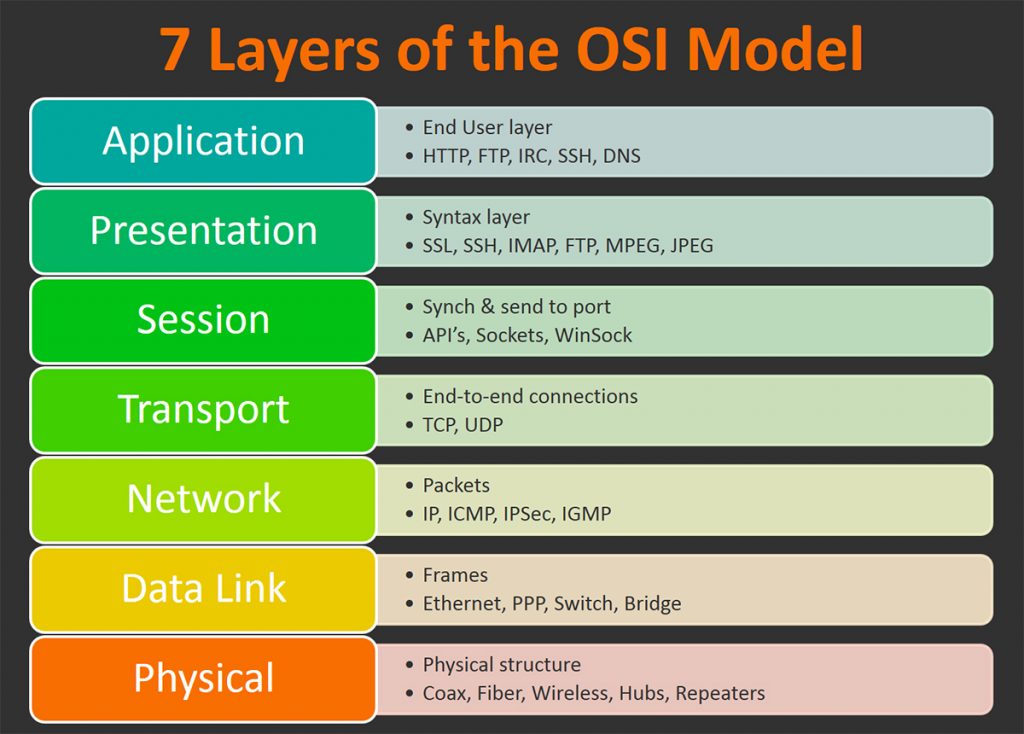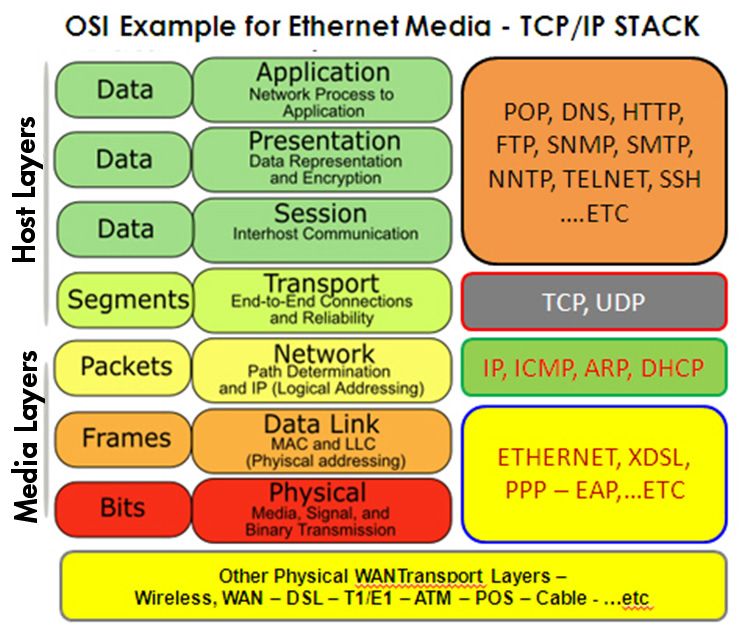
Read this article to find out if Unauthorized Port Scanning is a Crime?
OSI Model / TCP/IP Model
The TCP/IP model is a concise version of the OSI model. It contains four layers, unlike seven layers in the OSI model. The layers are:
- Process/Application Layer
- Host-to-Host/Transport Layer
- Internet Layer
- Network Access/Link Layer
Difference between TCP/IP and OSI Model:
|
OSI(Open System Interconnection) |
TCP/IP(Transmission Control Protocol / Internet Protocol) |
|
1. OSI is a generic,
protocol independent standard, acting as a communication gateway between the
network and end user. |
1. TCP/IP model is
based on standard protocols around which the Internet has developed. It is a
communication protocol, which allows connection of hosts over a network. |
|
2. In OSI model the
transport layer guarantees the delivery of packets. |
2. In TCP/IP model
the transport layer does not guarantees delivery of packets. Still the TCP/IP
model is more reliable. |
|
3. Follows vertical
approach. |
3. Follows
horizontal approach. |
|
4. OSI model has a
separate Presentation layer and Session layer. |
4. TCP/IP does not
have a separate Presentation layer or Session layer. |
|
5. Transport Layer
is Connection Oriented. |
5. Transport Layer
is both Connection Oriented and Connection less. |
|
6. Network Layer is
both Connection Oriented and Connection less. |
6. Network Layer is
Connection less. |
|
7. OSI is a
reference model around which the networks are built. Generally it is used as
a guidance tool. |
7. TCP/IP model is,
in a way implementation of the OSI model. |
|
8. Network layer of
OSI model provides both connection oriented and connectionless service. |
8. The Network layer
in TCP/IP model provides connectionless service. |
|
9. OSI model has a
problem of fitting the protocols into the model. |
9. TCP/IP model does
not fit any protocol |
|
10. Protocols are
hidden in OSI model and are easily replaced as the technology changes. |
10. In TCP/IP
replacing protocol is not easy. |
|
11. OSI model
defines services, interfaces and protocols very clearly and makes clear
distinction between them. It is protocol independent. |
11. In TCP/IP,
services, interfaces and protocols are not clearly separated. It is also
protocol dependent. |
|
12. It has 7 layers |
12. It has 4 layers |
Layer 2 Discovery - Arping / netdiscover
┌──(root💀kali)-[~] └─# arping 192.168.2.1 -c 3 1 ⨯ ARPING 192.168.2.1 60 bytes from 00:78:cd:00:fd:f4 (192.168.2.1): index=0 time=4.034 msec 60 bytes from 00:78:cd:00:fd:f4 (192.168.2.1): index=1 time=2.622 msec 60 bytes from 00:78:cd:00:fd:f4 (192.168.2.1): index=2 time=3.788 msec --- 192.168.2.1 statistics --- 3 packets transmitted, 3 packets received, 0% unanswered (0 extra) rtt min/avg/max/std-dev = 2.622/3.481/4.034/0.616 ms ┌──(root💀kali)-[~] └─#
┌──(root💀kali)-[~] └─# netdiscover -i eth0 -r 192.168.2.0/24 Currently scanning: Finished! | Screen View: Unique Hosts 172 Captured ARP Req/Rep packets, from 30 hosts. Total size: 10320 _____________________________________________________________________________ IP At MAC Address Count Len MAC Vendor / Hostname ----------------------------------------------------------------------------- 0.0.0.0 08:ea:40:f8:48:a2 48 2880 SHENZHEN BILIAN ELECTRONIC CO.,LTD 0.0.0.0 08:ea:40:fc:48:f3 46 2760 SHENZHEN BILIAN ELECTRONIC CO.,LTD 0.0.0.0 08:ea:40:f8:44:63 36 2160 SHENZHEN BILIAN ELECTRONIC CO.,LTD 192.168.2.1 00:78:cd:00:fd:f4 1 60 Ignition Design Labs 192.168.2.2 08:cc:68:40:71:c1 1 60 Cisco Systems, Inc 192.168.2.4 00:0c:29:1b:b7:e1 1 60 VMware, Inc.
Passive discover:
┌──(root💀kali)-[~] └─# netdiscover -p Currently scanning: (passive) | Screen View: Unique Hosts 307 Captured ARP Req/Rep packets, from 12 hosts. Total size: 18420 _____________________________________________________________________________ IP At MAC Address Count Len MAC Vendor / Hostname ----------------------------------------------------------------------------- 0.0.0.0 08:ea:40:f8:44:63 94 5640 SHENZHEN BILIAN ELECTRONIC CO.,LTD 192.168.2.155 24:be:05:e2:40:8f 13 780 Hewlett Packard 0.0.0.0 08:ea:40:f8:48:a2 82 4920 SHENZHEN BILIAN ELECTRONIC CO.,LTD 0.0.0.0 08:ea:40:fc:48:f3 82 4920 SHENZHEN BILIAN ELECTRONIC CO.,LTD 0.0.0.0 00:78:cd:03:d3:00 6 360 Ignition Design Labs 192.168.2.163 00:78:cd:03:d3:00 2 120 Ignition Design Labs 192.168.2.157 5c:cf:7f:73:26:55 13 780 Espressif Inc. 0.0.0.0 00:78:cd:01:05:b8 6 360 Ignition Design Labs 0.0.0.0 00:78:cd:03:d7:40 4 240 Ignition Design Labs
Layer 3 Discovery - Ping
- Ping
- ping 192.168.2.1
- Traceroute
- tracertout 8.8.8.8
- hping
- Use traceroute mode (–traceroute), be verbose (-V) in ICMP mode (-1) against the target (www.xxx.com):
- root@kali:~# hping3 --traceroute -V -1 www.xxx.com
- -q: brief output. -c: packets numbers. -d:packet site. -S:SYN packets. -p:Port Number. -w:tcp window size. --flood: shoot at discretion, replies will be ignored. --rand-source: hide source ip using a fake random ip.
- hping3 -q -c 10 -d 120 -S -w 64 -p 80 --flood --rand-source www.xxx.com
- Fping
- fping -g 192.168.2.0/24 -c 1 | grep ms > results.txt
- fping -g 192.168.2.0/24 -q -a
root@ubuntu20-04:~# cat fping.txt
10.0.0.1 : [0], 84 bytes, 0.12 ms (0.12 avg, 0% loss)
10.0.0.122 : [0], 84 bytes, 0.02 ms (0.02 avg, 0% loss)
root@ubuntu20-04:~# awk '//{printf "%s\n",$1}' fping.txt
10.0.0.1
10.0.0.122
Layer 4 Discovery - Nmap
According to the official Nmap website –
Nmap Target Selection
| Scan a single IP | nmap 192.168.2.1 |
| Scan a host | nmap www.test.com |
| Scan a range of IPs | nmap 192.168.2.1-20 |
| Scan a subnet | nmap 192.168.2.0/24 |
| Scan targets from a text file | nmap -iL list-of-ips.txt |
Nmap Port Selection
| Scan a single Port | nmap -p 22 192.168.2.1 |
| Scan a range of ports | nmap -p 1-100 192.168.2.1 |
| Scan 100 most common ports (Fast) | nmap -F 192.168.2.1 |
| Scan all 65535 ports | nmap -p- 192.168.2.1 |
Nmap Port Scan types
| Scan using TCP connect | nmap -sT 192.168.2.1 |
| Scan using TCP SYN scan (default) | nmap -sS 192.168.2.1 |
| Scan UDP ports | nmap -sU -p 123,161,162 192.168.2.1 |
| Scan selected ports - ignore discovery | nmap -Pn -F 192.168.2.1 |
Service and OS Detection
| Detect OS and Services | nmap -A 192.168.2.1 |
| Standard service detection | nmap -sV 192.168.2.1 |
| More aggressive Service Detection | nmap -sV --version-intensity 5 192.168.2.1 |
| Lighter banner grabbing detection | nmap -sV --version-intensity 0 192.168.2.1 |
Nmap Output Formats
| Save default output to file | nmap -oN outputfile.txt 192.168.2.1 |
| Save results as XML | nmap -oX outputfile.xml 192.168.2.1 |
| Save results in a format for grep | nmap -oG outputfile.txt 192.168.2.1 |
| Save in all formats | nmap -oA outputfile 192.168.2.1 |
Digging deeper with NSE Scripts
| Scan using default safe scripts | nmap -sV -sC 192.168.2.1 |
| Get help for a script | nmap --script-help=ssl-heartbleed |
| Scan using a specific NSE script | nmap -sV -p 443 –script=ssl-heartbleed.nse 192.168.2.1 |
| Scan with a set of scripts | nmap -sV --script=smb* 192.168.2.1 |
A scan to search for DDOS reflection UDP services
| Scan for UDP DDOS reflectors | nmap –sU –A –PN –n –pU:19,53,123,161 –script=ntp-monlist,dns-recursion,snmp-sysdescr 192.168.2.0/24 |
HTTP Service Information
| Gather page titles from HTTP services | nmap --script=http-title 192.168.2.0/24 |
| Get HTTP headers of web services | nmap --script=http-headers 192.168.2.0/24 |
| Find web apps from known paths | nmap --script=http-enum 192.168.2.0/24 |
Detect Heartbleed SSL Vulnerability
| Heartbleed Testing | nmap -sV -p 443 --script=ssl-heartbleed 192.168.2.0/24 |
IP Address information
| Find Information about IP address | nmap --script=asn-query,whois,ip-geolocation-maxmind 192.168.2.0/24 |
Layer 4 Discovery - Scapy
>>> ARP().display()
###[ ARP ]###
hwtype= 0x1
ptype= IPv4
hwlen= None
plen= None
op= who-has
hwsrc= 00:0c:29:fc:11:ce
psrc= 192.168.2.20
hwdst= 00:00:00:00:00:00
pdst= 0.0.0.0
>>> sr1(ARP(pdst="192.168.2.1"))
Begin emission:
Finished sending 1 packets.
*
Received 1 packets, got 1 answers, remaining 0 packets
<ARP hwtype=0x1 ptype=IPv4 hwlen=6 plen=4 op=is-at hwsrc=00:78:cd:00:fd:f4 psrc=192.168.2.1 hwdst=00:0c:29:fc:11:ce pdst=192.168.2.20 |<Padding load='\x00\x00\x00\x00\x00\x00\x00\x00\x00\x00\x00\x00\x00\x00\x00\x00\x00\x00' |>>
>>>
Default IP / ICMP header configuration:
>> IP().display()
###[ IP ]###
version= 4
ihl= None
tos= 0x0
len= None
id= 1
flags=
frag= 0
ttl= 64
proto= hopopt
chksum= None
src= 127.0.0.1
dst= 127.0.0.1
\options\
>>> ICMP().display()
###[ ICMP ]###
type= echo-request
code= 0
chksum= None
id= 0x0
seq= 0x0
>>> sr1(IP(dst="192.168.2.1")/ICMP(),timeout=1)
Begin emission:
Finished sending 1 packets.
*
Received 1 packets, got 1 answers, remaining 0 packets
<IP version=4 ihl=5 tos=0x0 len=28 id=50232 flags= frag=0 ttl=64 proto=icmp chksum=0x3143 src=192.168.2.1 dst=192.168.2.20 |<ICMP type=echo-reply code=0 chksum=0xffff id=0x0 seq=0x0 |<Padding load='\x00\x00\x00\x00\x00\x00\x00\x00\x00\x00\x00\x00\x00\x00\x00\x00\x00\x00' |>>>
>>> TCP().display()
###[ TCP ]###
sport= ftp_data
dport= http
seq= 0
ack= 0
dataofs= None
reserved= 0
flags= S
window= 8192
chksum= None
urgptr= 0
options= []
>>> sr1(IP(dst="192.168.2.1")/TCP(flags="S",dport=80),timeout=1)
Begin emission:
Finished sending 1 packets.
.*
Received 2 packets, got 1 answers, remaining 0 packets
<IP version=4 ihl=5 tos=0x0 len=44 id=0 flags=DF frag=0 ttl=64 proto=tcp chksum=0xb566 src=192.168.2.1 dst=192.168.2.20 |<TCP sport=http dport=ftp_data seq=3654116272 ack=1 dataofs=6 reserved=0 flags=SA window=29200 chksum=0x62bd urgptr=0 options=[('MSS', 1460)] |<Padding load='\x00\x00' |>>>
>>>












No comments:
Post a Comment